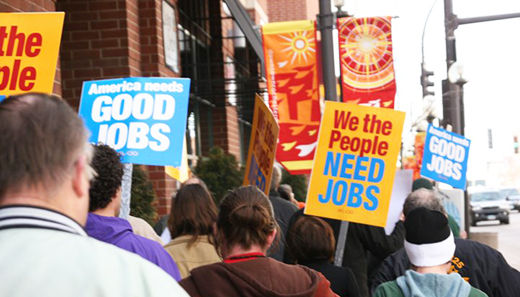
WASHINGTON – Six years after the onset of the Great Recession, the U.S. economy needs nearly 8 million jobs to return to pre-recession health, a new Economic Policy Institute report finds. In Six Years From its Beginning, the Great Recession’s Shadow Looms over the Labor Market, EPI economist Heidi Shierholz shows that while some economic indicators-such as the stock market and corporate profits-have improved substantially since the Great Recession, the labor market remains extraordinarily weak, with few job opportunities, crushing levels of long-term unemployment, and depressed wages.
Today’s weak labor market is due to businesses not seeing demand for goods and services rise rapidly enough to necessitate significantly increased hiring.
This demonstrates the importance of expansionary fiscal policy, including large-scale ongoing public investments, the restoration of public services and public-sector employment cut in the recession and its aftermath, and the renewal of federal unemployment insurance benefits.
All told, the economy still needs 7.9 million jobs to return to pre-recession health, and at the current pace of job growth, it would take roughly five more years to get there.
The weak labor market not only hurts job seekers, but also significantly impacts workers with jobs, who are faring much more poorly than they otherwise would be. The lack of available jobs shifts bargaining power away from workers and allows employers not to pay substantial wage increases to get and keep the workers they need. As such, real wages have dropped for the entire bottom 90 percent of workers.
“American workers are still reeling from the worst economic downturn since the Great Depression,” said Shierholz, “but it doesn’t have to be this way. Austerity driven by historically slow rates of public spending has held the economy back. Government policies, including investments in infrastructure, public sector jobs, and federal unemployment insurance benefits could generate demand for workers and increase employment quickly.”
Most of the improvement in the unemployment rate since its peak of 10.0 percent in the fall of 2009 has not been driven by increased employment, but rather by potential workers dropping out of, or never entering, the labor force because job opportunities are so weak. Including these workers would raise today’s unemployment rate to 10.3 percent.
“Today’s labor market weakness is not due to workers lacking skills for available jobs, but because there are not enough jobs-there are nearly three job seekers for every one open position,” said Shierholz.
Other key findings include:
The official annual unemployment rate-which is actually the average monthly unemployment rate for the year-is much lower than the share of the workforce that experienced unemployment at some point during the year. It is likely that 12.7 percent of all workers experienced unemployment at some point in 2013. The estimate is significantly higher for racial and ethnic minorities: It is likely 15.5 percent of Hispanic workers and 19.7 percent of black workers were unemployed at some point in 2013. Though the labor market is improving extremely slowly for all major groups, the employment situation of African Americans remains at something more akin to depression-level conditions.
Austerity in the public sector is a key driver of the economy’s weakness. Since the beginning of the recovery in June 2009, the public sector has lost 728,000 jobs. Just to keep up with population growth over this period, public-sector employment should have increased by around 750,000. That means the total gap in public-sector employment today is around 1.5 million jobs. Nearly 30 percent of that gap has occurred in local government education, which is mostly public K-12 employment.
Today’s labor market weakness is not due to skills mismatch or workers lacking skills for available jobs, but instead due to weak demand. If today’s high unemployment were a problem of skills mismatch, some sizable group or groups of workers would be now facing tight labor markets relative to 2007, before the recession started. Instead weak demand for workers is broad-based; job seekers dramatically outnumber job openings in every industry, and unemployment is significantly higher at every education level than in 2007.
Photo: PW












Comments